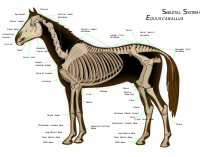
Photo from wikipedia
Lower ambient temperatures impair neuromuscular function and balance. However, whether lower ambient temperatures could alter joint angles and symmetry of lower limbs during crossing obstacles in males still remains unknown.… Click to show full abstract
Lower ambient temperatures impair neuromuscular function and balance. However, whether lower ambient temperatures could alter joint angles and symmetry of lower limbs during crossing obstacles in males still remains unknown. Therefore, we investigated whether there is reduction of ambient temperature (20°C; 15°C; 10°C) on lower limbs joint angles and symmetry when crossing obstacles in males. On three different occasions, eighteen male participants underwent 30 min exposure to three different environmental temperatures (10°C, 15°C, and 20°C), which was followed by the obstacle crossing test at 10%, 20%, and 30% of the participant leg length. In each trial, we assessed joint angles and symmetry of lower limbs when crossing obstacles at 10%, 20%, and 30% of the participants' leg length. The results showed that leading limb maximum joint angles were greater in 10°C than in 15°C and 20°C when leading limb crossed obstacle heights of 20% and 30% leg length (p < 0.05). Trailing limb maximum joint angles were not different (p > 0.05). Lower limb asymmetry increased when participants crossed obstacle heights of 20% and 30% leg length at 10°C (p < 0.05). This study concluded that in male participants, cold exposure can increase lower limb asymmetry to increase falling risk when crossing obstacles. Also, the increased leading limb joint angles and constant trailing limb joint angles increase safety during crossing obstacles.
Journal Title: Applied Bionics and Biomechanics
Year Published: 2022
Link to full text (if available)
Share on Social Media: Sign Up to like & get
recommendations!